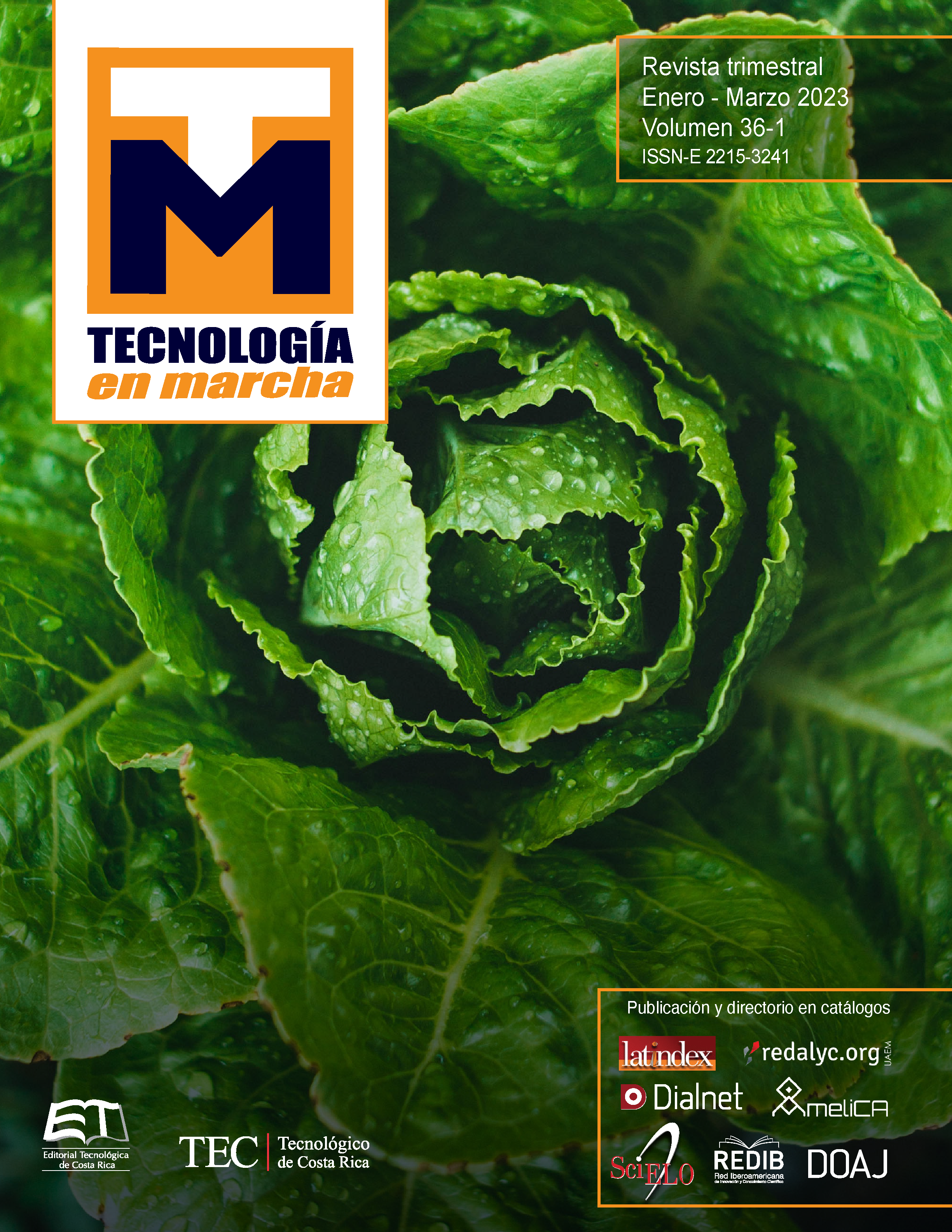Importance of uniformity coefficients in machine-assisted agricultural operations (technical note)
Main Article Content
Abstract
The efficiency of mechanized agricultural work affects the general yield of crops and the uniformity of production, determining variables in the adequate definition of differentiated management areas. Implement consistency tests impact implement purchasing and implement management decisions. The objective of this work is to promote the efficient use of agricultural machinery in the field and to evaluate agricultural operations for the proper use of production resources. Uniformity coefficients of the work carried out with each of the implements tested were determined, as well as other operative variables that influence their performance. The most uniform tasks are those carried out with vertical tillage implements (CU > 80%), although they demand more power to break the soil structure, the volumetric seeder is more uniform at low speeds (CU = 86.73%) and the sprayer presented more homogeneous applications at low operating pressures (CU = 98%). The uniformity measurements and calibration activities of the implements allowed identifying critical points in the machinery, and substantiating the importance of determining them for the continuous improvement of agricultural operations aimed at achieving homogeneous crop yields.
Article Details

This work is licensed under a Creative Commons Attribution-NonCommercial-NoDerivatives 4.0 International License.
Los autores conservan los derechos de autor y ceden a la revista el derecho de la primera publicación y pueda editarlo, reproducirlo, distribuirlo, exhibirlo y comunicarlo en el país y en el extranjero mediante medios impresos y electrónicos. Asimismo, asumen el compromiso sobre cualquier litigio o reclamación relacionada con derechos de propiedad intelectual, exonerando de responsabilidad a la Editorial Tecnológica de Costa Rica. Además, se establece que los autores pueden realizar otros acuerdos contractuales independientes y adicionales para la distribución no exclusiva de la versión del artículo publicado en esta revista (p. ej., incluirlo en un repositorio institucional o publicarlo en un libro) siempre que indiquen claramente que el trabajo se publicó por primera vez en esta revista.
References
J. Hikmat Namiq Al-Talabani and M. Ahmed Jalal Al-Sammarraie, “THE EFFECT OF PLOWING AND PULVERIZATION SYSTEMS ON SOME PLANT INDICATORS OF ONION,” PLANT Arch., vol. 21, no. Suppliment-1, pp. 851–853, Jan. 2021, doi: 10.51470/PLANTARCHIVES.2021.v21.S1.129.
E. M. Albornoz, A. C. Kemerer, R. Galarza, N. Mastaglia, R. Melchiori, and C. E. Martínez, “Development and evaluation of an automatic software for management zone delineation,” Precis. Agric., vol. 19, no. 3, pp. 463–476, 2018, doi: 10.1007/s11119-017-9530-9.
E. Soza, E. Pezzoni, G. Botta, M. Tourn, and D. Agnes, “Eficiencia de implantación de trigo con labranza en franjas a distintas velocidades de avance,” Rev. la Fac. Agron., vol. 25, no. 2, pp. 121–127, 2005.
A. Rodríguez et al., “Implications of crop model ensemble size and composition for estimates of adaptation effects and agreement of recommendations,” Agric. For. Meteorol., vol. 264, pp. 351–362, Jan. 2019, doi: 10.1016/j.agrformet.2018.09.018.
E. S. Osuna-Ceja, F. Garibaldi Márquez, and R. V. García Hernández, “Desempeño de un subsolador integral biomimético para laboreo sustentable de suelos agrícolas,” Acta Univ., vol. 29, pp. 1–14, 2019, doi: 10.15174/au.2019.1968.
N. Rangeon, L. Aciar, R. Osinaga, J. Arzeno, and C. Sánchez, “Análisis de la resistencia a la penetración y humedad de suelo como indicadores de calidad en distintos sistemas de labranza,” XXI Congr. Argentino la Cienc. del suelo. Semiáridoun desafío para la Cienc. del Suelo, 2008.
Arrazate-Oropeza, Gómez-Calderón, and Villagra-Mendoza, “Comparación de patinaje bajo diferentes tipos de labranza de suelo,” in XII Congreso Latinoamericano y del Caribe de Ingeniería Agrícola, 2016, p. 649.
Hang, Huang, and Zhu, “Analysis of the movement behaviour of soil between subsoilers based on the discrete element method,” J. Terramechanics, vol. 74, pp. 35–43, 2017, doi: 10.1016/j.jterra.2017.10.002.
G. Bernal, M. Posada, and V. Piedrahíta, “Evaluación Técnica de Tres Tipos de Micronairs que se Utilizan en la Fumigación Aérea del Banano.,” Rev. Fac. Nac. Agron. Medellín, vol. 51, no. 1, pp. 237–252, 1998.
F. Manqui, J. Riquelme, and A. Villablanca, “Sembradoras de granos,” NFORMATIVO INIA N°69, 2012. [Online]. Available: https://biblioteca.inia.cl/bitstream/handle/123456789/4699/NR40613.pdf?sequence=1&isAllowed=y. [Accessed: 15-Nov-2021].
M. Villón, Hidrología estadística. Editorial Tecnológica de Costa Rica, 2006.
G. V. Cormack and M. R. Grossman, “Quantifying bias and variance of system rankings,” SIGIR 2019 - Proc. 42nd Int. ACM SIGIR Conf. Res. Dev. Inf. Retr., pp. 1089–1092, 2019, doi: 10.1145/3331184.3331356.
J. G. Arias-Badilla, E. A. Esquivel-Segura, and R. Campos-Rodríguez, “Evaluación de la densidad de siembra y nivel de fertilización en arroz, para las variedades Palmar-18, Lazarroz FL y NayuribeB FL, en Parrita (Pacífico Central), Costa Rica,” Rev. Tecnol. en Marcha, Jul. 2020, doi: 10.18845/tm.v33i3.4363.

